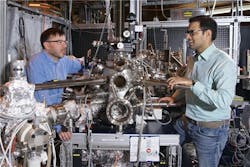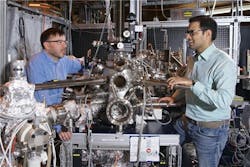Breakthroughs Put Spotlight on Catalysis
[pullquote]Separate research projects in Switzerland and Singapore have made breakthroughs in understanding catalyst activity that could affect the way the chemical industry understands and uses catalysts.
In the Swiss project, researchers at the Paul Scherrer Institute (PSI), Villigen, and ETH Zurich have developed a method for improving the precision of experiments used to find catalysts and optimize their use.
“We have found a way to construct catalytic model systems — that is, experimental setups — accurate to one nanometer and then track the chemical reactions of individual nanoparticles,” says Waiz Karim, who is affiliated with both the Laboratory for Micro and Nanotechnology at the PSI and the Institute for Chemical and Bioengineering at ETH Zurich. “This makes it possible to selectively optimize the efficiency of catalytic processes.”
“To do that, you need a deeper understanding of what is going on at the molecular level,” adds study leader Jeroen van Bokhoven, head of the Laboratory for Catalysis and Sustainable Chemistry at the PSI and professor of heterogeneous catalysis at ETH Zurich.
Figure 1. Using the Synchrotron Light Source at the Paul Scherrer Institute, researchers Armin Kleibert (l) and Waiz Karim (r) have been able to carry out very precise studies into catalytic processes. Source: Paul Scherrer Institute/Markus Fischer.
For their experiment the team used iron oxide, which was converted to iron through the addition of hydrogen and a platinum catalyst. The platinum splits the molecular hydrogen into elemental hydrogen, which can more easily react with iron oxide.
The researchers used electron-beam lithography to place miniscule particles of iron oxide and platinum, consisting of just a few atoms each, on a support. The two different particle types are placed in pairs, but with differing distances between them.
[callToAction ]
“Thus we were able to test 16 different situations at once and control the size and spacing of the particles with one-nanometer accuracy,” Karim explains. Then the researchers flooded the model with hydrogen and used single-particle spectroscopy to observe the results.
“Not only is the precision of the particle positioning new, but the correspondingly accurate observation of chemical reactions — including simultaneous observation of many particles in different situations — had not been possible before: in previous studies, placement of the nanoparticles of two different materials could be off by up to 30 nanometers,” Karim notes.
They also found that some of the chemical reactions take place on an even smaller scale. One of these, the hydrogen spillover effect, was discovered in 1964 but has never been understood or visualized until now, the team says.
“We were able to prove that how far the hydrogen flows depends on the support material,” adds Karim. The farther it flows, the more the spillover can contribute to the catalysis. If the support consists of aluminum oxide, for example, which itself can’t be reduced, the hydrogen flows no farther than 15 nanometers. In contrast, with reducible titanium oxide, it flows over the whole surface. “Clearly, for some support materials, it is important how tightly the particles sit on them.”
Van Bokhoven believes this combination of nanofabrication of the model system, precise measurement of chemical reactions, and theoretical modeling could be an enormous benefit to the chemical industry and chemical science overall: “With this we are opening up a whole new dimension for the investigation and understanding of catalytic processes. And with this understanding, industrial production processes can be optimized in a much more targeted way.”
Meanwhile, a new theoretical model shows how water droplets grow around tiny particles on a surface. The work, carried out Singapore’s Agency for Science, Technology and Research (A*STAR) Institute of High Performance Computing, has combined modeling and computation in an effort to better predict how water condenses around tiny particles. The resulting mathematical model has been used to test particle size, surface tension and the attraction or repulsion of the surface on which the droplet forms. The actions of water droplets were filmed as they condensed around micron-sized silicon dioxide particles on a glass slide.
Writing in the Nature journal Scientific Reports, Tran Si Bui Quang and others from the Institute describe a good agreement between their experimental results and their simulations. When extended to particle clusters, the model’s prediction was again shown to be consistent with what was seen in experiments.
The researchers note that by building on these findings to better understand condensation and surface wettability at the very small scale, eventually they will be able to tackle problems involving capillary adhesion between wetted particles and substrates, or wetted fine particulates and granules — such as those posed by many catalysts commonly used today.


